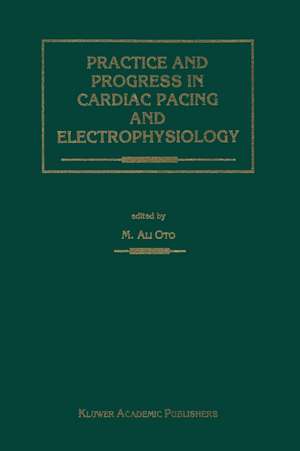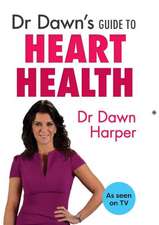Practice and Progress in Cardiac Pacing and Electrophysiology: Developments in Cardiovascular Medicine, cartea 183
Editat de Ali Otoen Limba Engleză Paperback – 20 sep 2011
This volume provides highlights of many of the recent and most important technological advances and concepts in cardiac electrotherapy, written by the most prominent figures in the field, for the internists, clinical cardiologists and cardiologists who are practising in arrhythmias and antiarrhythmic therapy.
The book is divided into five parts, each focusing on an exciting group of topics. Part One is a highlight of some of the hit points in arrhythmology. Part Two is a quick reference to the current concepts in non-invasive electrocardiology. Part Three, cardiac pacing, is enhanced by the introductory chapter of S. Furman, which gives the state-of-the-art in electrical cardiac stimulation for 1995. This part also reviews the technical advances, new perspectives in the indications of cardiac pacing, as well as the management of complications. Radiofrequency ablation as a challenging antiarrhythmic therapeutic strategy is thoroughly reviewed and the hottest topics are highlighted in Part Four. Part Five is dedicated to implantable cardioverter-defibrillators with several exciting topics, including driving with implantable devices.
Din seria Developments in Cardiovascular Medicine
- 5%
 Preț: 1484.53 lei
Preț: 1484.53 lei - 5%
 Preț: 375.17 lei
Preț: 375.17 lei - 5%
 Preț: 354.10 lei
Preț: 354.10 lei - 5%
 Preț: 1419.03 lei
Preț: 1419.03 lei - 5%
 Preț: 376.43 lei
Preț: 376.43 lei - 5%
 Preț: 1098.27 lei
Preț: 1098.27 lei - 5%
 Preț: 1438.38 lei
Preț: 1438.38 lei - 5%
 Preț: 376.78 lei
Preț: 376.78 lei - 5%
 Preț: 368.37 lei
Preț: 368.37 lei - 5%
 Preț: 380.25 lei
Preț: 380.25 lei - 5%
 Preț: 2117.58 lei
Preț: 2117.58 lei - 5%
 Preț: 367.28 lei
Preț: 367.28 lei - 5%
 Preț: 366.56 lei
Preț: 366.56 lei - 5%
 Preț: 371.10 lei
Preț: 371.10 lei - 5%
 Preț: 370.94 lei
Preț: 370.94 lei - 5%
 Preț: 783.18 lei
Preț: 783.18 lei - 5%
 Preț: 713.18 lei
Preț: 713.18 lei - 5%
 Preț: 1098.27 lei
Preț: 1098.27 lei - 5%
 Preț: 375.49 lei
Preț: 375.49 lei - 5%
 Preț: 373.47 lei
Preț: 373.47 lei - 5%
 Preț: 723.93 lei
Preț: 723.93 lei - 5%
 Preț: 1104.13 lei
Preț: 1104.13 lei - 5%
 Preț: 2117.20 lei
Preț: 2117.20 lei - 5%
 Preț: 716.09 lei
Preț: 716.09 lei - 5%
 Preț: 372.03 lei
Preț: 372.03 lei - 5%
 Preț: 722.33 lei
Preț: 722.33 lei - 5%
 Preț: 660.07 lei
Preț: 660.07 lei - 5%
 Preț: 375.34 lei
Preț: 375.34 lei - 5%
 Preț: 1423.22 lei
Preț: 1423.22 lei - 5%
 Preț: 715.35 lei
Preț: 715.35 lei - 5%
 Preț: 790.69 lei
Preț: 790.69 lei - 5%
 Preț: 720.68 lei
Preț: 720.68 lei - 5%
 Preț: 3185.49 lei
Preț: 3185.49 lei - 5%
 Preț: 1418.27 lei
Preț: 1418.27 lei - 5%
 Preț: 784.64 lei
Preț: 784.64 lei - 5%
 Preț: 714.63 lei
Preț: 714.63 lei - 5%
 Preț: 370.74 lei
Preț: 370.74 lei - 5%
 Preț: 376.22 lei
Preț: 376.22 lei - 5%
 Preț: 660.85 lei
Preț: 660.85 lei - 5%
 Preț: 368.37 lei
Preț: 368.37 lei
Preț: 722.33 lei
Preț vechi: 760.35 lei
-5% Nou
Puncte Express: 1083
Preț estimativ în valută:
138.26€ • 150.23$ • 116.21£
138.26€ • 150.23$ • 116.21£
Carte tipărită la comandă
Livrare economică 21 aprilie-05 mai
Preluare comenzi: 021 569.72.76
Specificații
ISBN-13: 9789401065825
ISBN-10: 9401065829
Pagini: 416
Ilustrații: XX, 391 p.
Dimensiuni: 160 x 240 x 22 mm
Greutate: 0.58 kg
Ediția:Softcover reprint of the original 1st ed. 1996
Editura: SPRINGER NETHERLANDS
Colecția Springer
Seria Developments in Cardiovascular Medicine
Locul publicării:Dordrecht, Netherlands
ISBN-10: 9401065829
Pagini: 416
Ilustrații: XX, 391 p.
Dimensiuni: 160 x 240 x 22 mm
Greutate: 0.58 kg
Ediția:Softcover reprint of the original 1st ed. 1996
Editura: SPRINGER NETHERLANDS
Colecția Springer
Seria Developments in Cardiovascular Medicine
Locul publicării:Dordrecht, Netherlands
Public țintă
ResearchCuprins
Foreword.- Preface.- List of Contributors.- One: Arrhythmias and Antiarrhythmic Treatment strategies.- 1. Endpoints and trials: a matter of life and death. Classification of death in patients under antiarrhythmic treatment.- 2. The role of transient ischaemia in the pathophysiology of ventricular arrhythmias in patients with coronary artery disease.- 3. Sudden death and tachyarrhythmias in athletes.- 4. The evaluation of antiarrhythmics.- 5. Atrial fibrillation: maintaining the sinus rhythm.- 6. Arrhythmogenic right ventricular dysplasia.- Two: Non-Invasive Electrocardiology.- 7. Signal averaged electrocardiogram. Current applications and limitations.- 8. Can analysis of heart rate variability predict arrhythmias and antiarrhythmic effects?.- 9. QT dispersion.- 10. Use of baroreceptor reflex sensitivity in the prediction of risk after myocardial infarction.- 11. Ambulatory monitoring of T-wave alternans for detection of cardiac electrical instability: scientific rationale and technical considerations.- Three: Cardiac Pacing.- 12. The state of electrical cardiac stimulation — 1995.- 13. Long-term rate adaptive atrial (AAIR) pacing: is it feasible?.- 14. Single lead atrial synchronised ventricular (VDD) pacing.- 15. Benefits of sensor driven dual chamber pacing.- 16. Cardiopulmonary evaluation of patients with rate responsive pacemakers.- 17. Programming the upper rate behaviour and the atrial escape interval in paced patients with unstable atrium.- 18. Automatic mode switching in DDDR pacemakers.- 19. Pacing to prevent arrhythmias: bradycardia/tachycardia syndrome.- 20. Managing paroxysmal atrial tachycardias in patients with pacemakers.- 21. Pacing to prevent atrial fibrillation.- 22. The paradigm shift: pacing to prevent arrhythmias. Ventricular tachycardia.- 23. Howmay dilated cardiomyopathy benefit from cardiac pacing?.- 24. Various methods of monitoring the autonomic nervous system using the pacing lead as a sensor. Clinical results and prospectives.- 25. Rationale for the management of pacemaker and defibrillator complications.- Four: Radiofrequency Ablation of Arrhythmias.- 26. Radiofrequency ablation of atrial flutter.- 27. The spectrum of “Mahaim-like” accessory connections and their associated ablation techniques.- 28. New approaches to ablation of left-sided and posteroseptal accessory pathways.- 29. Advances in transcatheter endocardial mapping and radiofrequency ablation of ventricular arrhythmias.- 30. Catheter ablation of ventricular tachycardia in patients with coronary heart disease.- Five: Implantable Cardioverter-Defibrillators.- 31. Internal atrial defibrillation and implantable atrial defibrillators.- 32. The cardiologist’s dilemma: drugs or ICDs in patients with severe ventricular dysfunction.- 33. Can pump failure in ICD patients with low ejection fraction be avoided by adding new pacing modes to current ICD’s?.- 34. Long-term outcome with transvenous (-subcutaneous) defibrillation leads.- 35. Insights into ventricular tachycardia onset mechanism from analysis of stored ICD electrograms.- 36. Managing the problem of atrial tachyarrhythmias in patients with ICD’s.- 37. Technological advances in implantable cardioverter defibrillator leads and waveforms: paving the way for smaller ICDs.- 38. Driving restrictions after cardioverter/defibrillator implantation.- 39. Arrhythmias, implantable devices and driving “The United Kingdom Advisory Panel Experience”.









